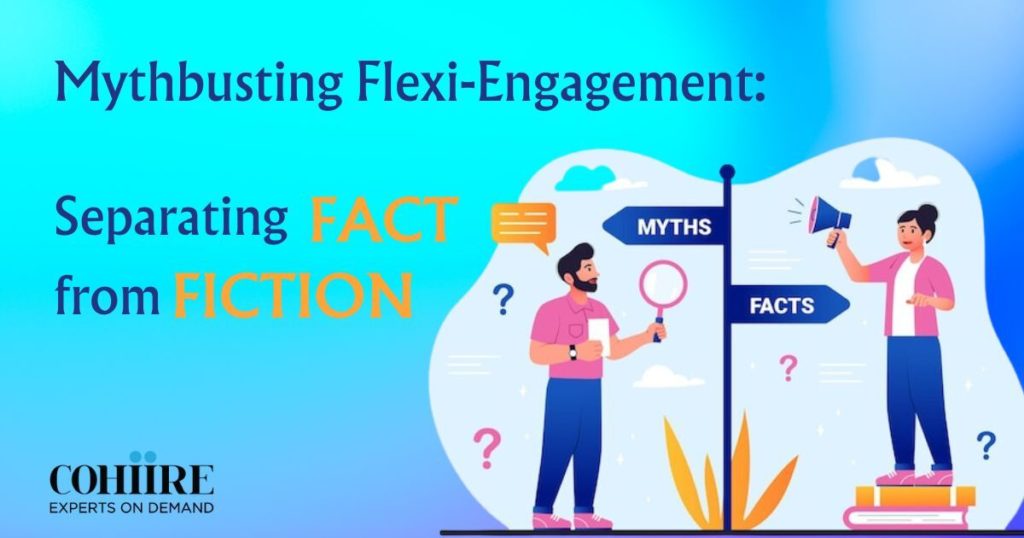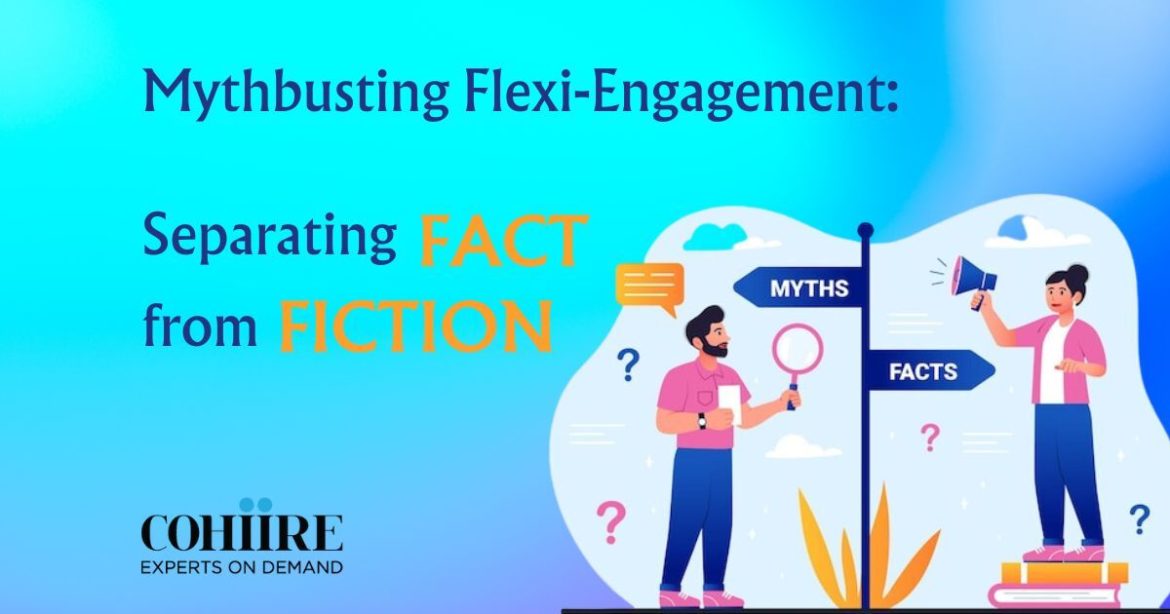
Flexi-engagement or hiring C-Suite flexible experts on a short-term basis, is slowly becoming popular among businesses of all sizes. More people are realizing the importance of this approach, yet there are several myths that prevent some businesses from taking advantage of this strategy.
Startups and growing businesses often experience fluctuations in their resource requirements. Flexi-engagement CXOs provide scalability and flexibility, allowing organizations to scale their leadership capacity based on their current needs. They can be engaged during critical phases like fundraising, mergers and acquisitions, or market expansions.
But it does not mean that flexi-engagement is limited to startups. When engaging flexi CXOs, organizations have the opportunity to facilitate knowledge transfer to internal teams. These temporary executives can mentor and coach existing employees, transferring their skills and expertise to enhance the capabilities of the organization’s workforce.
The steady growth of flexi-engagement CXOs over the past two years indicates that organizations are recognizing the benefits of this approach. It allows them to mitigate risks associated with long-term executive hires and provides them with a competitive edge in today’s rapidly evolving business landscape. However, it’s important for organizations to strike a balance between temporary engagements and building a stable core leadership team to ensure continuity and long-term success.
In this article, we’ll examine and debunk some of the most common myths around flexi-engagement.
Myth #1: Flexi-engagement is only for startups and small businesses
Contrary to popular belief, businesses of all sizes can benefit from flexi-engagement. For example, larger businesses can use flexi-engagement to bring in specialized talent on a short-term basis, which can be more cost-effective than hiring a full-time employee for the same role.
So, saying that it is only suitable for startups or small businesses would be limiting the potential benefits of flexi-engagement. In fact, even established companies can leverage the flexibility and cost-effectiveness of flexi-engagement to achieve their business goals more efficiently.
A well-established technology company decided to undertake a digital transformation project. Instead of hiring a full-time Chief Technology Officer (CTO), they opted for a flexi-engagement approach. They brought in a highly experienced CTO on a short-term basis to lead the transformation initiative. This allowed the company to leverage the expertise of the flexi-engagement CTO without the long-term commitment of a full-time hire, proving that flexi-engagement is not limited to startups or small businesses.
Myth #2: Flexi-engagement is only for low-skilled roles
One of the most widespread misconceptions is that flexible engagement is only appropriate for entry-level or low-skilled positions. Flexi-engagement is actually applicable to a variety of occupations, including management and executive positions and other emerging fields that require specialized knowledge like data science, data analytics, digital transformation, cyber security and sales.
A global manufacturing company, wants to improve its supply chain management processes. They decided to engage a flexi-expert in logistics and supply chain optimization. The flexi-engagement expert, with years of experience in the industry, designs and implements an efficient supply chain strategy, optimizing inventory levels and reducing costs. This example demonstrates that flexi-engagement is not limited to low-skilled roles but extends to highly specialized areas like logistics and supply chain management.
Myth #3: Flexi-engagement is less secure than traditional employment
Some businesses are reluctant to use flexi-engagement because they believe it’s less secure than traditional employment. However, this is a misconception. While flexi-engagement does involve a shorter-term commitment than traditional employment, there are many ways to ensure security and protection for both parties.
For example, contracts can be used to establish clear expectations and protect the interests of both the business and the flexi-engaged worker. A renowned management consulting firm engaged a flexi-engagement partner who is an expert in cybersecurity to assist them in strengthening their IT infrastructure and ensuring data security for their clients. To ensure security and protect both parties, the consulting and the flexi-engagement partner signed a comprehensive contract that outlines confidentiality clauses, data protection measures, and dispute resolution mechanisms.
Myth #4: Flexi-engagement is less beneficial for workers than traditional employment
Finally, it is popularly believed that flexi-engagement is less beneficial for workers than traditional employment. In reality, flexi-engagement offers many benefits for workers, such as flexibility, variety, and the ability to work on multiple projects with different businesses. Additionally, because flexi-engagement workers are often specialized and in-demand, they can often command higher rates than traditional employees.
An experienced marketing professional with expertise in digital marketing and social media, recently decided to work as a flexi-engagement marketing consultant instead of pursuing a full-time job. This allowed him to work on multiple projects simultaneously, offering his services to different companies in need of marketing expertise. By doing so, he enjoyed the flexibility of managing his own time, exploring diverse industries, and commanding higher rates for his specialized skills. This example showcases the benefits that flexi-engagement can offer to workers in terms of flexibility, variety, and financial rewards.
In conclusion, flexi-engagement is a powerful tool that businesses can use to bring in specialized talent, fill temporary gaps, and achieve their goals more efficiently. By understanding and debunking the myths around flexi-engagement, businesses can unlock the full potential of this strategy and reap the benefits for themselves and their workers.




